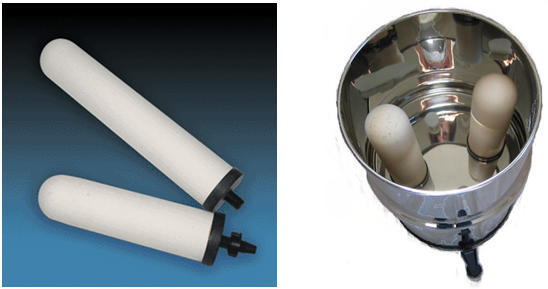Water Treatment
ระบบผลิตน้ำดี และน้ำประปา (Water Treatment System) ระบบกรองน้ำ และระบบผลิตน้ำบริสุทธิ์, ระบบผลิตน้ำสะอาดบรรจุขวด ETPC รับออกแบบและติดตั้งพร้อมจำหน่ายวัสดุอุปกรณ์สำหรับระบบผลิตน้ำดี
Ceramic Filter
Ceramic water filters are an inexpensive and effective type of water filter, that rely on the small pore size of ceramic material to filter dirt, debris, and bacteria out of water
Method of action
As with most filtration methods, water is carefully introduced to one side of the filter, which acts to block the passage of anything larger than a water molecule. Only water and smaller contaminants will pass through to the other "clean" side of the filter. Additionally many ceramic water filters (CWF) should be treated with silver, which is in a form that will not leach away. The silver helps to kill or incapacitate bacteria and prevent the growth of mold and algae in the body of the filter. The two most common types of CWF are pot type and candle type filters. CWF systems consist of a porous ceramic filter that sits on top of a plastic or ceramic receptacle. Contaminated water is poured in the filter and passes through the filter into the receptacle below. The receptacle usually is fitted with a tap. Contaminants which are larger than the minute holes of the ceramic structure will remain in the top half of the unit, which can be cleaned by brushing the inside of the top section with a soft brush and rinsing it out. Hot water and soap can also be used. Some ceramic filters (like ceramic candle filters) also use active carbon which absorbs compounds such as chlorine. Filters with active carbon need to be replaced periodically because the carbon becomes clogged with foreign material. This may not always work
There are also portable ceramic filters, such as the MSR Miniworks, which work via manual pumping, and in-line ceramic filters, which filters drinking water that comes through household plumbing. Cleaning these filters is the same as with the clay pot filter but also allows for reverse-flow cleaning, wherein clean water is forced through the filter backwards, pushing any contaminants out of the ceramic pores.
This filtration type does not remove chemical contaminants per se. However, some manufacturers incorporate a high-performance activated carbon core inside the ceramic filter cartridge that reduces organic & metallic contaminants. The major risks to the success of all forms of ceramic filtration are hairline cracks and cross-contamination. If the unit is dropped or otherwise abused, the brittle nature of ceramic materials can allow fine, hard to see cracks, and can allow larger contaminants through the filter. Extensive work on brittle nature and fracture toughness of the ceramic water filter material is elaborately explained in this fabulous read [1]. This also provides the most comprehensive literature review of types of ceramic filters. Also, if the "clean" water side of the ceramic membrane is brought into contact with dirty water, hands, cleaning cloths, etc, then the filtration will be ineffective. If such contact occurs, the clean side of the filter should be thoroughly sterilized before reuse.




